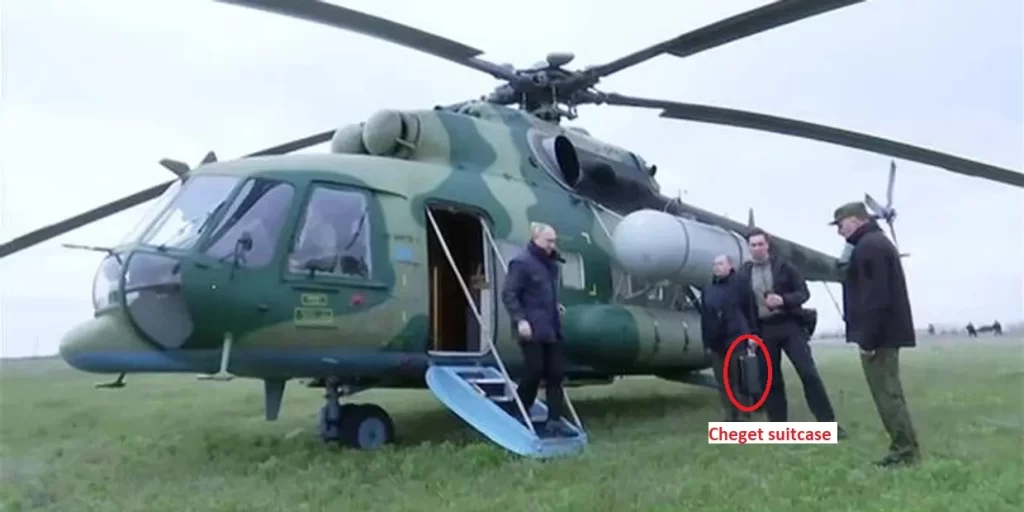On April 18, Russian President Vladimir Putin travelled to the Kherson and Luhansk regions. According to the President’s press staff, Vladimir Putin’s working visits to the Dnepr group of troops and the National Guard’s “Vostok” headquarters in the Luhansk People’s Republic were unplanned.
The Kremlin said they were not anticipating President Putin’s visits to the Kherson region, the Lugansk People’s Republic (LPR), or the Dnepr and Vostok headquarters.
During his visits, the President heard updates from military heads about the Kherson, Zaporizhzhia, and Luhansk fronts.
This is Putin’s first visit to the Kherson region and Luhansk. On March 19, the President visited Mariupol in the Donetsk Region, which Russia refers to as Donetsk People’s Republic (DPR). Earlier in the day, Putin visited the command post of the special military operation in Rostov-on-Don, where he met with the Russian Armed Forces General Staff chief and senior military leaders.
The nuclear button
Russian news outlets have noticed the nuclear suitcase in one of the Kremlin’s newly published photographs. The telegram channel of the news outlet Pravda first reported that Vladimir Putin had a special communications officer with him who held the Cheget [Nuclear suitcase] terminal of the Kazbek system [The Combat Management Automated (computer-aided) System (CMAS) of Nuclear Strategic Forces], the official name for the “nuclear button”. TV journalist Olga confirmed this on the air of the special issue of “60 Minutes” Skabeeva.
The officer was not wearing the Russian armed forces uniform, maybe for stealth reasons.
Also, the video released by the Kremlin and TV Zvezda shows that it is not a thin suitcase with an armoured shield, as is commonly believed, but rather “the same pot-bellied Samsonite.”
When the President travels, his trusty Cheget suitcase stays on high alert. In her opinion, this is normal, Olga Skabeeva stated.
Dmitry Peskov, the Russian President’s spokesman, said earlier that Putin is provided with the essential means of communication, including strategic communications and control systems for nuclear forces, meaning that he can keep in touch with his staff no matter where they are.
Russian specialists say it is possible to communicate and launch attacks anywhere in the world, from Kherson or Australia or Siberia on the President’s birthday, thanks to the deployment of specialised ground equipment that can be transported easily and flights of repeater aircraft and air control posts.
The President is always surrounded by officers with a “nuclear suitcase.” During walks, talks, and negotiations, they need 10 seconds to get close to the leader and open the device. When the President travels or stays at a house, they remain in the rooms next to his. On the road, they ride in a security car not far away. When the head of state is at an event or on an aeroplane (or train), they are 10-15 metres away.
What is in the nuclear suitcase?
Even though it’s commonly referred to as the “nuclear button,” which refers to the portable user terminal for special communications, no red buttons initiate anything.

As the declassified photos of the “nuclear suitcases” of the leaders of the USSR and Boris Yeltsin showed, the suitcase contains devices and an emergency communication setup system (from anywhere and in any conditions), a screen for displaying information (what flies and where, what answer options are there), buttons for choosing options, and a red button that stops the launch of all (or part) of the nuclear weapons. There are also buttons to enter the code. The newer versions are likely to have other tools and keys, but the “suitcases” are kept as secret as possible.
Each of Russia’s three most powerful people carries a nuclear briefcase: the President, the Minister of Defence, and the Chief of the General Staff. These briefcases are used to transmit the secret codes that authorise the use of nuclear weapons to the SRF’s command posts. When the code is received from at least two terminals, permission is granted. With this method, it is possible to protect against making mistakes when using nuclear weapons.
In the event of an attack on Moscow or its allies using nuclear weapons or other weapons of mass destruction, or in the event of aggression using conventional weapons, Moscow has the right to use nuclear weapons in retaliation. This includes situations where “the state’s very survival is threatened.”
It was claimed in March 2022 that Vladimir Putin ordered Defence Minister Sergei Shoigu and Chief of the General Staff Valery Gerasimov to switch the strategic forces to a special mode of combat duty owing to threats from the West.
The President of the United States has a similar bag called “nuclear football.”
